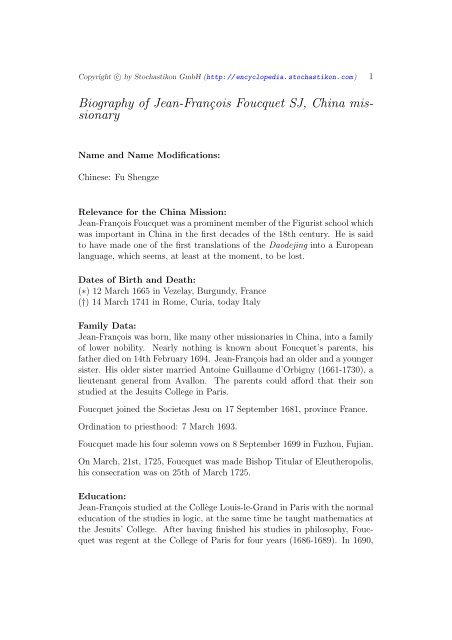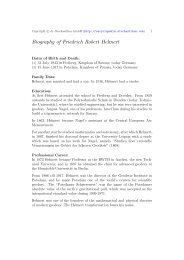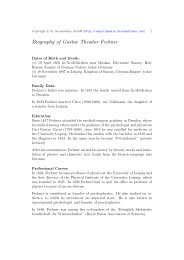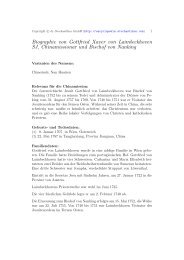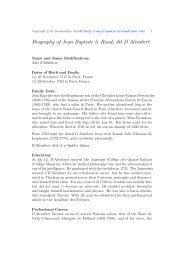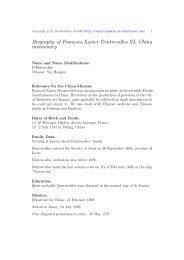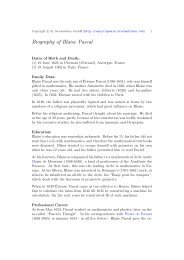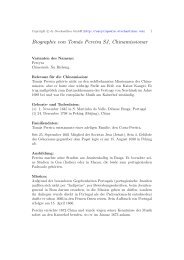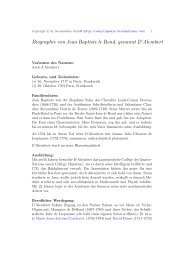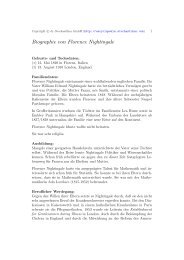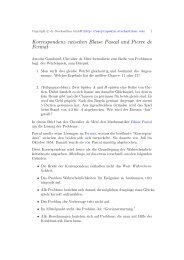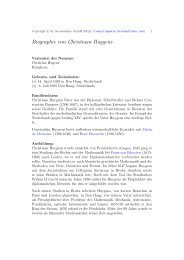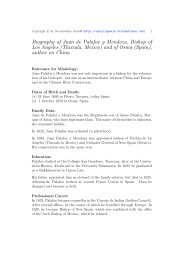Biography of Jean-François Foucquet SJ, China mis- sionary
Biography of Jean-François Foucquet SJ, China mis- sionary
Biography of Jean-François Foucquet SJ, China mis- sionary
Create successful ePaper yourself
Turn your PDF publications into a flip-book with our unique Google optimized e-Paper software.
Copyright c○ by Stochastikon GmbH (http://encyclopedia.stochastikon.com) 1<br />
<strong>Biography</strong> <strong>of</strong> <strong>Jean</strong>-<strong>François</strong> <strong>Foucquet</strong> <strong>SJ</strong>, <strong>China</strong> <strong>mis</strong><strong>sionary</strong><br />
Name and Name Modifications:<br />
Chinese: Fu Shengze<br />
Relevance for the <strong>China</strong> Mission:<br />
<strong>Jean</strong>-<strong>François</strong> <strong>Foucquet</strong> was a prominent member <strong>of</strong> the Figurist school which<br />
was important in <strong>China</strong> in the first decades <strong>of</strong> the 18th century. He is said<br />
to have made one <strong>of</strong> the first translations <strong>of</strong> the Daodejing into a European<br />
language, which seems, at least at the moment, to be lost.<br />
Dates <strong>of</strong> Birth and Death:<br />
(∗) 12 March 1665 in Vezelay, Burgundy, France<br />
(†) 14 March 1741 in Rome, Curia, today Italy<br />
Family Data:<br />
<strong>Jean</strong>-<strong>François</strong> was born, like many other <strong>mis</strong>sionaries in <strong>China</strong>, into a family<br />
<strong>of</strong> lower nobility. Nearly nothing is known about <strong>Foucquet</strong>’s parents, his<br />
father died on 14th February 1694. <strong>Jean</strong>-<strong>François</strong> had an older and a younger<br />
sister. His older sister married Antoine Guillaume d’Orbigny (1661-1730), a<br />
lieutenant general from Avallon. The parents could afford that their son<br />
studied at the Jesuits College in Paris.<br />
<strong>Foucquet</strong> joined the Societas Jesu on 17 September 1681, province France.<br />
Ordination to priesthood: 7 March 1693.<br />
<strong>Foucquet</strong> made his four solemn vows on 8 September 1699 in Fuzhou, Fujian.<br />
On March, 21st, 1725, <strong>Foucquet</strong> was made Bishop Titular <strong>of</strong> Eleutheropolis,<br />
his consecration was on 25th <strong>of</strong> March 1725.<br />
Education:<br />
<strong>Jean</strong>-<strong>François</strong> studied at the Collège Louis-le-Grand in Paris with the normal<br />
education <strong>of</strong> the studies in logic, at the same time he taught mathematics at<br />
the Jesuits’ College. After having finished his studies in philosophy, <strong>Foucquet</strong><br />
was regent at the College <strong>of</strong> Paris for four years (1686-1689). In 1690,
Copyright c○ by Stochastikon GmbH (http://encyclopedia.stochastikon.com) 2<br />
<strong>Foucquet</strong> started his studies <strong>of</strong> theology <strong>of</strong> four years, his ordination was<br />
after three years. In 1694, he went to Rouen for the Tertiar.<br />
Mission:<br />
<strong>Foucquet</strong> was recruited for the <strong>China</strong> <strong>mis</strong>sion by Joachim Bouvet (1656-<br />
1730).<br />
Departure: in the beginning <strong>of</strong> January 1698 from Brest, France, on the ship<br />
“La Zelande”. In Port-Louis <strong>Foucquet</strong> changed to the ship “Le Bon”, which<br />
started his voyage on February 21, 1698.<br />
Arrival on 24th <strong>of</strong> July 1699 in Amoy, Fujian, <strong>China</strong>.<br />
Piao: 28th <strong>of</strong> May 1707.<br />
Pr<strong>of</strong>essional Career:<br />
After his arrival in Amoy, <strong>Foucquet</strong> worked as a <strong>mis</strong><strong>sionary</strong> in the provinces<br />
Jiangxi, Nanzhang and Fuzhou. <strong>Foucquet</strong> belonged since the early time <strong>of</strong><br />
his stay in <strong>China</strong> to the Figurist circle around Joachim Bouvet, they corresponded<br />
with others in a kind <strong>of</strong> small scientific-<strong>mis</strong><strong>sionary</strong> private academy<br />
following the example <strong>of</strong> Chinese academies. In 1711, he was ordered to<br />
Peking to help Bouvet to do research in the Chinese Canonical book Yijing;<br />
he stayed till 1717.<br />
But in Peking, <strong>Foucquet</strong> was ordered by his superiors to work on astronomy,<br />
so that he hardly could help Bouvet and could not work on Figurism. <strong>Foucquet</strong><br />
wrote several astronomical and mathematical treatises for the emperor<br />
Kangxi. The French superior in Peking, Pierre Vincent de Tartre (1669-1724)<br />
and the Jesuits Visitor Kilian Stumpf (1655-1720) thought that the research<br />
on the Yijing was a danger for the <strong>mis</strong>sion, because at that time the Chinese<br />
Rites Controversy was still alive. The Figurists seemed to be dangerous, because<br />
their interpretation <strong>of</strong> the Chinese books and the Chinese history gave<br />
the impression that the Chinese already possessed the whole Christian revelation,<br />
which only needed to be looked for in the right, namely the Figurist,<br />
way. <strong>Foucquet</strong>’s specialty was Daoism and its Christian interpretation and<br />
less the Yijing. His relations to his brethren became worse and worse, because<br />
his research on Figurism was blocked. Finally he decided to return to<br />
Europe. He was called back to Europe by his order on his own wish in 1720<br />
and left <strong>China</strong> on January 9, 1722. He took with him his Chinese library<br />
consisting <strong>of</strong> 4000 books, despite the fact that such books normally belonged<br />
to the order.
Copyright c○ by Stochastikon GmbH (http://encyclopedia.stochastikon.com) 3<br />
<strong>Foucquet</strong> reached Paris on June 8, 1723. The books he brought to Europe<br />
are scattered now on different libraries in Europe. On April 8, 1723, he left<br />
the Society <strong>of</strong> Jesus, on June 8, he went to Rome, where he lived in the house<br />
<strong>of</strong> the Sacra Congregatio de Propaganda Fide. Two years later, on March 21,<br />
1725, he was appointed Bishop Titular <strong>of</strong> Eleutheropolis and on 25 March<br />
<strong>of</strong> the same year consecrated by pope Benedict XIII. In Europe, <strong>Foucquet</strong><br />
was in contact a.o. with Louis de Rouvroy, duc de Saint-Simon (1675-1755),<br />
Montesquieu (1689-1755) and Voltaire (1694-1778).<br />
It is said that <strong>Foucquet</strong> made a translation <strong>of</strong> the Daode jing, which seems<br />
to be lost.<br />
Publications <strong>Jean</strong>-<strong>François</strong> <strong>Foucquet</strong>:<br />
• “Bian xi Ru li”, manuscript between 1710 and 1720, about the Rites<br />
Controversy.<br />
• “Ju gu jing zhuan ka tian xiang bu jun qi”, manuscript between 1710<br />
and 1715.<br />
• “Dui shu guang yun”, manuscript about trigonometry, between 1710<br />
and 1720.<br />
• “Li fa wen da”, 25 novembre 1715, manuscript presented to the Kangxi<br />
emperor.<br />
• “Tian yuan wen da”, 2 juan (origin and foundations <strong>of</strong> astronomy),<br />
manuscript 1712.<br />
• “Lettre, au Duc de La Force, 26 novembre 1702”, Lettres édifiantes<br />
et curieuses, vol. V (Paris 1705) pp. 129-238; Lettres édifiantes et<br />
curieuses, vol. V (Paris 1724) pp. 129-238; Lettres édifiantes et curieuses,<br />
vol. XVII (Paris 1781) pp. 91-159; Lettres édifiantes et curieuses,<br />
vol. XVII (Paris 1810) pp. 73-128; Lettres édifiantes et curieuses, vol.<br />
XXVI (Paris 1829-32) pp. 222-285; Lettres édifiantes et curieuses, vol.<br />
III (Paris 1843) pp. 53-70; Lettres édifiantes et curieuses, vol. III<br />
(Paris 1877) pp. 53-70; Lettres édifiantes et curieuses, vol. (extract)<br />
(Paris 1979) pp. 86-90; Lettres édifiantes et curieuses, vol. II (Paris<br />
1838) pp. 239-247; Joseph Stöcklein (ed.), Der Neue Welt-Bott, vol.<br />
I,3 (Augsburg 1726) # 69.
Copyright c○ by Stochastikon GmbH (http://encyclopedia.stochastikon.com) 4<br />
• “L’Avis de Mgr <strong>Foucquet</strong> S.J., 20 juillet 1726”, in: <strong>François</strong> Bontinck,<br />
La lutte autour de la liturgie chinoise aux XVIIe et XVIIIe siècles (Louvain<br />
1962) pp. 533-535.<br />
• “Tabula chronologica Historiae Sinicae connexa cum cyclo qui vulgo<br />
kia-tse dicitur, 1729”, English: “An Explanation <strong>of</strong> the New Chronological<br />
Table <strong>of</strong> the Chinese History”, in: Philosophical Transactions<br />
<strong>of</strong> the Royal Society <strong>of</strong> London XXXVI, no. 415 (1730) pp. 397-424.<br />
• “Attestation de M. [<strong>François</strong>] Fouquet S.J., Évêque d’Eleutheropolis,<br />
1720”, C.P. Platel (ed.), Mémoires historiques presentés en 1744 au<br />
Souverain Pontif Benoit XIV sur les <strong>mis</strong>sion des Pères Jésuites aux<br />
Indes orientales VII (Lisbonne 1766) pp. 124-128.<br />
• “Lettre, à Carlo-Ambrogio Mezzabarba, 5. Décembre 1720”, in: Anecdotes<br />
sur l’état de la Religion dans la Chine ou Relation de M. le Cardinal<br />
de Tournon, Patriarche d’Antiochie, Visiteur Apostolique; avec<br />
pouvoir de Legat a latere à la Chine, vol. IV (Paris 1734) pp. 55f.<br />
• “Autre Lettre du même Pere Fouquet, Du 6. Décembre [1720, à Mezzabarba]”,<br />
in: Anecdotes sur l’état de la Religion dans la Chine ou<br />
Relation de M. le Cardinal de Tournon, Patriarche d’Antiochie, Visiteur<br />
Apostolique; avec pouvoir de Legat a latere à la Chine, vol. IV<br />
(Paris 1734) pp. 57f.<br />
• “Lettre, 24. Décembre 1720 [à Mezzabarba]”, in: Anecdotes sur l’état<br />
de la Religion dans la Chine ou Relation de M. le Cardinal de Tournon,<br />
Patriarche d’Antiochie, Visiteur Apostolique; avec pouvoir de Legat a<br />
latere à la Chine, vol. IV (Paris 1734) pp. 61-74.<br />
• “Lettres au Cardinal Gualterio 1723-1728”, in: Henri Cordier, “Documents<br />
inédits pour servir à l’histoire ecclésiastique de l’Extrême-Orient<br />
I: Correspondance du Père <strong>Foucquet</strong> avec le cardinal Gualterio”, Revue<br />
de l’Extrême-Orient I (1883) pp. 16-51, and more letters by <strong>Foucquet</strong>,<br />
pp. 382-422; 523-573.<br />
• “Lettre au P. de Goville, 30 mars 1736”, in: Memorie istoriche presentate<br />
al sommo Pontifice Benedetto XIV intorno alle <strong>mis</strong>sioni dell’Indie<br />
orientali, vol. II (Lucca 1744) pp. 214-236, repr. in: C.P. Platel (ed.),<br />
Mémoires historiques presentés en 1744 au Souverain Pontif Benoit<br />
XIV sur les <strong>mis</strong>sion des Pères Jésuites aux Indes orientales, vol. II<br />
(Lisbonne 1766) pp. 77-106.
Copyright c○ by Stochastikon GmbH (http://encyclopedia.stochastikon.com) 5<br />
• “Catalogus omnium <strong>mis</strong>sionariorum qui Sinarum Imperium ad hæc<br />
usque tempora ad prædicandum Jesu Xti Evangelium ingressi sunt”,<br />
Henri Cordier, “Documents inédits pour servir à l’histoire ecclésiastique<br />
de l’Extrême-Orient. V.”, Revue de l’Extrême-Orient II (1883) pp. 58-<br />
71.<br />
• 14 Letters are in: Virgile Pinot, Documents inédits relatifs à la connaissance<br />
de la Chine en France de 1685 à 1740 (Paris 1932), with the<br />
following addressees:<br />
– “Fourmont, 28 août 1722”, pp. 10-11;<br />
– “Fourmont, 17 décembre 1722”, pp. 12-13;<br />
– “Mr. X..., 31 août 1729”, pp. 14-16;<br />
– “L’abbé de Rothelin, 15 novembre 1729”, 17-19;<br />
– “L’abbé Bignon, 27 novembre 1729”, pp. 20-21;<br />
– “L’abbé de Rothelin, 25 avril 1735”, pp. 22-23;<br />
– “L’abbé de Rothelin, 25 mai 1735”, p. 24;<br />
– “L’abbé de Rothelin, 22 février 1736”, p. 25;<br />
– “L’abbé de Rothelin, 14 novembre 1736”, pp. 26-27;<br />
– “L’abbé de Rothelin, 21 août 1737”, pp. 28-29;<br />
– “L’abbé de Rothelin, 29 août 1737”, pp. 30-31;<br />
– “L’abbé de Rothelin, 10 avril 1738”, p. 32;<br />
– “L’abbé de Rothelin, 28 août 1738”, p. 33;<br />
– “L’abbé de Rothelin, 3 novembre 1738”, p. 34.<br />
• Quotations from letters <strong>of</strong> the years 1723-1724, in: Hélène Himelfarb /<br />
Bruno Neveu, “Saint-Simon, les Jésuites et la Chine”, Cahiers Saint-<br />
Simon V (1977) pp. 37-48; VI (1978) pp. 13-29; VII (1979) pp. 26-36;<br />
VIII (1980) pp. 13-36; IX (1981) pp. 17-34.<br />
• For the manuscript letters <strong>of</strong> <strong>Foucquet</strong> s. John W. Witek, Controversial<br />
Ideas in Europe and <strong>China</strong>. A <strong>Biography</strong> <strong>of</strong> <strong>Jean</strong>-<strong>François</strong> <strong>Foucquet</strong><br />
S.J. (1665-1741) (Rome, Paris 1982) pp. 356-407.<br />
The most important manuscripts on Daoism:<br />
• “Préface sur le Tao et son école”, in: BAV, Borg. cin. 374, ff. 1-39, s.<br />
Witek, <strong>Foucquet</strong>, p. 345.
Copyright c○ by Stochastikon GmbH (http://encyclopedia.stochastikon.com) 6<br />
• “Problème théologique proposé aux sçavans zelés pour la gloire de Jésus<br />
Christ, et aux ministres évangéliques qui travaillent à la conversion de<br />
la Chine sçavoir si on peut dire et comment on peut dire que dans<br />
l’unique vrai sens des anciens livres chinois le charactere tao signifie le<br />
dieu qui adorent les chrétiens”, in: AR<strong>SJ</strong>, JS IV, 3, 1-321; BAV, Borg.<br />
Cin. 371, (1), 1-158 sowie BAV, Borg. cin. 371, (2), 159-321; Borg.<br />
lat. 565, ff. 523-544v; Borg. cin. 374 (1), ff. 5-228, Witek, p. 347.<br />
• “Dissertatio de vera origine doctrinæ et monumentorum Sinensium<br />
contenta quatuor propositionibus. Quartæ propositionis secunda pars,<br />
nempe Cabalæ veteris reliquæ potissimum apud Sinas remanserunt nec<br />
ab illis quæ summo in pretio, tota gens habet, vetustissi<strong>mis</strong> monumentis<br />
diversæ. Caput secundum. De arcana doctrina Confucii et monumentorum<br />
Sinensium”, in: BAV, Borg. lat. 566, 359-602v; BAV, Borg.<br />
cin. 358 (1), 1-56; BAV, Borg. cin. 358 (2), 1-184; BAV, Borg. cin.<br />
437, 1-171, s. Witek, p. 347.<br />
• “Propylæum templi veteris sapientiæ seu aditus ad antiqua monumenta<br />
Sinensium ostenditur quænam origo sit illorum monumentorum. Tum<br />
proponitur problema theologicum eruditis legis Evangelicæ præconibus<br />
in vinea Sinica laborantibus propagatoribus Christi gloria studiosis, an<br />
et qua ratione dici possit in unico vero et genuino veterum monumentorum<br />
sensu per characterem Tao designari Deum Summum quem nos<br />
Christiani colimus”, in: BAV, Borg. lat. 566, ff. 327-336v; 612-613v;<br />
682-689v; AR<strong>SJ</strong>, Jap. Sin. IV, 4 (1), A, ff. 1-26; AR<strong>SJ</strong>, JS IV, (2), 5,<br />
ff. 1-220, teilweise Kopien in: AR<strong>SJ</strong>, JS IV, 4, (1), A, pp. 1-26; (3),<br />
A, pp. 1-20; (3), B, pp. 1-8; BAV, Borg. cin, 358, (3), pp. 17-158;<br />
BAV, Borg. cin. 358, (4), pp. 159-272; BAV, Borg. lat. 566, 614-665v;<br />
690-780; 785-906; BL, Add. Mss. 26818, 146-158; cf. Dehergne, “Les<br />
historiens. . . ”, pp. 63f; Witek, pp. 347f.<br />
Many <strong>of</strong> <strong>Foucquet</strong>’s manuscripts are in the Biblioteca Apostolica Vaticana<br />
in Rom. S. dazu: Takata Tokio (ed.): Paul Pelliot, Inventaire sommaire des<br />
manuscrits et imprimé chinoise de la Bibliothèque Vaticane (Italian School<br />
<strong>of</strong> East Asian Studies Reference Series 1) (Kyoto 1995).<br />
<strong>Jean</strong>-<strong>François</strong> <strong>Foucquet</strong> Bibliography:<br />
• Henri Bernard, “Les adaptations chinoises des ouvrages européens”, Monumenta<br />
Serica X (1945) pp. 1-57; pp. 309-388; Monumenta Serica XIX (1960)<br />
pp. 349-383.<br />
• Maurice Courant, Catalogue des livres chinois, coréens, japonais etc., vols.<br />
I-III (Paris 1910).
Copyright c○ by Stochastikon GmbH (http://encyclopedia.stochastikon.com) 7<br />
• Joseph Dehergne, Répertoire des Jésuites de Chine de 1582 à 1800 (Rome,<br />
Paris 1973) p. 21.<br />
• Paul Pelliot, Inventaire sommaire des manuscrits et imprimé chinoise de<br />
la Bibliothèque Vaticane, Takata Tokio (ed.) (Italian School <strong>of</strong> East Asian<br />
Studies Reference Series 1) (Kyoto 1995).<br />
• Louis Pfister, Notices biographiques et bibliographiques sur les Jésuites de<br />
l’ancienne Mission de Chine 1552-1773 (Chang-hai 1932-34) pp. 549-554.<br />
• Carlos Sommervogel, Bibliothèque de la Compagnie de Jésus III (Bruxelles<br />
1892) pp. 903-905.<br />
• Nicolas Standaert (ed.), Handbook <strong>of</strong> Christianity in <strong>China</strong>. Volume One:<br />
635-1800 (Handbook <strong>of</strong> Oriental Studies, section 4: <strong>China</strong> 15/1. Handbuch<br />
der Orientalistik, Abt. 4: <strong>China</strong> 15) (Leiden, Boston, Köln 2001).<br />
• Robert Streit, Bibliotheca Missisionum, vol. VII (Freiburg 1932) pp. 68-<br />
70.<br />
• Yu Dong, Catalogo delle opere cinesi <strong>mis</strong>sionarie della Biblioteca Apoatolica<br />
Vaticana (XVI-XVIII sec.) (Città del Vaticano 1996).<br />
• Johannes Beckmann, “Ein Dokument zur Geschichte des chinesischen<br />
Klerus im 18. Jahrhundert”, Neue Zeitschrift für Missionswissenschaft 1<br />
(1945) pp. 184-193.<br />
• Johannes Beckmann, “Die katholischen Missionare und der Taoismus”,<br />
Neue Zeitschrift für Missionswissenschaft 26 (1970) pp. 1-17.<br />
• Henri Bernard-Maître, “De la question des termes à la querelle des Rites<br />
de Chine. Le dossier <strong>Foucquet</strong> de 1711”, Neue Zeitschrift für Missionswissenschaft<br />
14 (1958) pp. 178-195; pp. 267-275.<br />
• Henri Bernard-Maître, “Un ami du président de Brosses, <strong>Jean</strong>-Nicolas <strong>Foucquet</strong>,<br />
ancien jésuite de Chine”, Mémoires de l’Académie des sciences, arts et<br />
belles-lettres de Dijon (1947-1953) pp. 112-118.<br />
• Henri Bernard-Maître, “<strong>Jean</strong>-<strong>François</strong> <strong>Foucquet</strong>”, DHGE XVII (1970) pp.<br />
1258-59.<br />
• <strong>François</strong> Bontinck, La lutte autour de la liturgie chinoise aux XVIIe et<br />
XVIIIe siècles (Louvain 1962).<br />
• Claudia von Collani, Die Figuristen in der <strong>China</strong><strong>mis</strong>sion (Frankfurt, Bern,<br />
Las Vegas 1981).<br />
• Claudia von Collani, P. Joachim Bouvet S.J. Sein Leben und sein Werk<br />
(Monumenta Serica Monograph Series 17) (Nettetal 1985).<br />
• Claudia von Collani (ed.), Eine wissenschaftliche Akademie für <strong>China</strong>.<br />
Briefe des <strong>China</strong><strong>mis</strong>sionars Joachim Bouvet S.J. an Gottfried Wilhelm von<br />
Leibniz und <strong>Jean</strong>-Paul Bignon über die Erforschung der chinesischen Kultur,<br />
Sprache und Geschichte (Studia Leibnitiana Sonderheft 18) (Stuttgart<br />
1989).
Copyright c○ by Stochastikon GmbH (http://encyclopedia.stochastikon.com) 8<br />
• Claudia von Collani, “Daoismus und Figurismus. Zur Inkulturation des<br />
Christentums in <strong>China</strong>”, in: Adrian Hsia (ed.), Tao. Reception in East and<br />
West (Frankfurt 1994) pp. 3-34.<br />
• Claudia von Collani, “Kilian Stumpf <strong>SJ</strong> zur Lage der <strong>China</strong><strong>mis</strong>sion im<br />
Jahre 1708”, in: Neue Zeitschrift für Missionswissenschaft 51 (1995) pp.<br />
117-144, 175-209.<br />
• Claudia von Collani, “Figurismus - Anfang und Ende einer kontextuellen<br />
Theologie in <strong>China</strong>”, in: R. Malek, (ed.), Fallbeispiel <strong>China</strong>. Ökumenische<br />
Beiträge zu Religion, Theologie und Kirche im chinesischen Kontext (Nettetal<br />
1996) pp. 89-127.<br />
• Claudia von Collani, “The first Encounter <strong>of</strong> the West with the Yijing.<br />
Introduction to and Edition <strong>of</strong> Letters and Latin Translations by French Jesuits<br />
from the 18th Century”, Monumenta Serica LV (2007) pp. 227-387.<br />
• Claudia von Collani, Harald Holz, Konrad Wegmann (eingeleitet, erstmalig<br />
herausgegeben, übersetzt und erläutert), Ur<strong>of</strong>fenbarung und Daoismus. Jesuitische<br />
Missionshermeneutik des Daoismus (Reihe Daodejing-Forschungen<br />
/ Series Daodejing Research vol. 1) (European University Press, Bochum<br />
2008).<br />
• Fernand Combaluzier, “Nouvelles de Chine (1729-1734). Fragments du<br />
copie-lettres de Mgr <strong>Jean</strong>-<strong>François</strong> <strong>Foucquet</strong>”, Revue d’histoire des <strong>mis</strong>sions<br />
XV (1938) pp. 130-134.<br />
• Emily Byrne Curtis, “<strong>Foucquet</strong>’s list: Translation and comments on the<br />
color ’Blue skye after rain”’, Journal <strong>of</strong> glass studies 41 (1991) pp. 147-152.<br />
• Joseph Dehergne, “Les historiens Jésuites du Taoisme”, in: Actes du Colloque<br />
international de Sinologie, Chantilly: La Mission Française de Pékin<br />
aux XVIIe et XVIIIe siècles (Paris 1976) pp. 59-67.<br />
• Giacomo di Fiore, “Carita e reclusione nell’Europa di Settecento: Le disavventure<br />
carcerarie di due cinesi al seguito di <strong>Jean</strong>-<strong>François</strong> <strong>Foucquet</strong> e di<br />
Matteo Ripa”, in: Michele Fatica (ed.), Scritture di storia (Napoli 2005) pp.<br />
49-89.<br />
• Christine Maria Grafinger, “Die Handschriften des <strong>China</strong><strong>mis</strong>sionars <strong>Jean</strong><br />
<strong>François</strong> <strong>Foucquet</strong> S.J. an der Vatikanischen Bibliothek”, Archivum Historicum<br />
Societatis Jesu 63 (1994) pp. 161-169.<br />
• Hermann Harder, “La question du ’gouvernement’ de la Chine au XVIIIe<br />
siècle. Montesquieu et de Brosses chez Mgr <strong>Foucquet</strong> à Rome”, Actes du<br />
IIIe Colloque international de Sinologie, Chantilly 1980. Appréciation par<br />
l’Europe de la tradition chinoise à partir du XVIIe siècle (Paris 1993) pp.<br />
79-92.<br />
• Hélène Himelfarb / Bruno Neveu, “Saint-Simon, les Jésuites et la Chine”,<br />
Cahiers Saint-Simon V (1977) pp. 37-48; VI, 1978, 13-29; VII, 1979, 26-36;<br />
VIII, 1980, 13-36; IX, 1981, 17-34.
Copyright c○ by Stochastikon GmbH (http://encyclopedia.stochastikon.com) 9<br />
• Catherine Jami, <strong>Jean</strong>-<strong>François</strong> <strong>Foucquet</strong> et la modernisation de la science<br />
en Chine. La “Nouvelle Méthode d’Algèbre” (Université de Paris VII 1986).<br />
• Catherine Jami, Hashimoto Keizo, “Kepler’s laws in <strong>China</strong>: a <strong>mis</strong>sing link?<br />
<strong>Jean</strong>-<strong>François</strong> <strong>Foucquet</strong>’s ’Li fa wen da”’, Historia scientiarum 6,3 (1997) pp.<br />
171-185.<br />
• Catherine Jami, Hashimoto Keizo, “New evidence <strong>of</strong> the trans<strong>mis</strong>sion <strong>of</strong><br />
European astronomy to <strong>China</strong>: <strong>Jean</strong>-<strong>François</strong> <strong>Foucquet</strong>’s ’Li fa wen da”’, in:<br />
Kim Yung Sik, Francesca Bray (eds.), Current perspectives in the history <strong>of</strong><br />
science in East Asia (Soul 1999) pp. 487-496.<br />
• Fortunato Margiotti, “Materiale <strong>mis</strong>sionario nel Fondo Borgia Latino della<br />
Biblioteca Apostolica Vaticana”, Euntes Docete XXI (1968) pp. 424-435.<br />
• <strong>Jean</strong>-Claude Martzl<strong>of</strong>f, “La science astronomique européenne au service<br />
de la diffusion du Catholicisme en Chine. L’oeuvre astronomique de <strong>Jean</strong>-<br />
<strong>François</strong> <strong>Foucquet</strong> (1665-1741)”, Mélanges de l’Ecole française de Rome CI<br />
(1989) 2, pp. 973-989.<br />
• <strong>Jean</strong>-Claude Martzl<strong>of</strong>f, “Espace et temps dans les textes chinois d’astronomie<br />
et de technique mathématiques aux XVIIe et XVIIIe siècles”, in: L’Europe<br />
en Chine. Interactions scientifiques, religieuses et culturelles aux XVIIe et<br />
XVIIIe siècles (Mémoires de l’Institut des Hautes Etudes chinoises XXXIV)<br />
(Paris 1993) pp. 217-230.<br />
• <strong>Jean</strong>-Claude Martzl<strong>of</strong>f, “A Glimpse <strong>of</strong> Post-Verbiest Period: <strong>Jean</strong>-<strong>François</strong><br />
<strong>Foucquet</strong>’s Lifa Wenda (Dialogue on Calendrical Techniques) and the Modernization<br />
<strong>of</strong> Chinese Astronomy or Urania’s Feet Unbound”, in: John W.<br />
Witek (ed.), Ferdinand Verbiest (1623-1688). Jesuit Mis<strong>sionary</strong>, Scientist,<br />
Engineer and Diplomat (Monumenta Serica Monograph Series XXX) (Nettetal<br />
1994) pp. 519-529.<br />
• K. W. Müller, “<strong>Jean</strong>-<strong>François</strong> <strong>Foucquet</strong>’s Reading <strong>of</strong> the Daode Jing and<br />
Other Chinese Classics”, in: Dong Xi Jiao Liu Lun Tan, Di Er Ji, Huang Shi<br />
Jian (Forum für Ost-West-Austausch Band 2) (Shanghai 2001) pp. 296-313.<br />
• Arnold H. Rowbotham, “<strong>China</strong> in the “Esprit des lois”: Montesquieu and<br />
Mgr <strong>Foucquet</strong>”, Comparative Literature II (1950) pp. 354-359.<br />
• Arnold H. Rowbotham, “The Jesuit Figurists and Eighteenth-Century Religious<br />
Thought”, Journal <strong>of</strong> the History <strong>of</strong> Ideas XVII (1956) pp. 471-485.<br />
• Paul A. Rule, K’ung-tzu or Confucius? The Jesuit Interpretation <strong>of</strong> Confucianism<br />
(Sydney 1986).<br />
• Jonathan Spence, The Question <strong>of</strong> Hu (New York 1988), German: Der<br />
kleine Herr Hu (München 1990).<br />
• John W. Witek, “<strong>Jean</strong>-<strong>François</strong> <strong>Foucquet</strong>. Un controversiste jésuite en<br />
Chine et en Europe”, in: Actes du Colloque international de Sinologie, 1974<br />
(Paris 1976) pp. 115-135.<br />
• John W. Witek, Controversial Ideas in Europe and <strong>China</strong>. A <strong>Biography</strong> <strong>of</strong>
Copyright c○ by Stochastikon GmbH (http://encyclopedia.stochastikon.com) 10<br />
<strong>Jean</strong>-<strong>François</strong> <strong>Foucquet</strong> S.J. (1665-1741) (Rome, Paris 1982).<br />
• John W. Witek, “<strong>Jean</strong>-<strong>François</strong> <strong>Foucquet</strong> et les livres chinois de la Bibliothèque<br />
nationale”, in: Actes du IIe Colloque international de Sinologie,<br />
Chantilly 1977 (Paris 1980) pp. 146-171.<br />
• Ad Dudink, Nicolas Standaert, Chinese Christian Texts Database (CCT-<br />
Database) http://www.arts.kuleuven.be/sinology/cct/cct (24.04.2009).<br />
• http://www.bdcconline.net/en/stories/f/foucquet-jeanfrancois.php (25 April<br />
2009).<br />
Author(s) <strong>of</strong> this contribution:<br />
Claudia von Collani<br />
Version: 1.00


